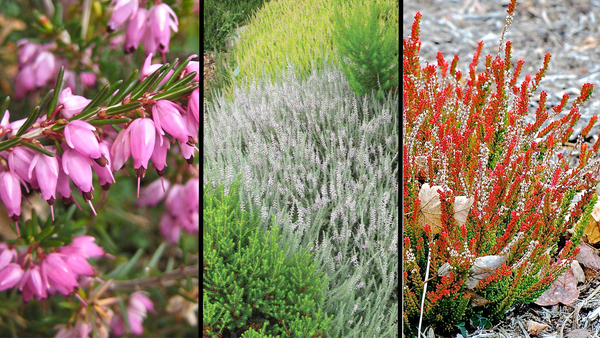
Heaths and heathers are easy to grow if you give them the right conditions. They only loathe clay soil and summer humidity (although you can find exceptions), and you can’t do much about those. Other than that, you can provide the conditions or find the species or cultivar that suits your spot. The best source for in-depth information is Gardening with Hardy Heathers by David Small and Ella May T. Wulff.
Siting:
While exceptions exist, heaths and heathers prefer full sun (though partial shade may be required for golden-leaved cultivars) and moist but well-drained, acidic soil.
 |
 |
Planting:
Getting your plants established means encouraging their fine roots to go outward into the surrounding soil. If your plants are rootbound, tease out the roots, or even cut into the root ball if needed. Water them well, and keep them moist. The thing that kills most newly planted heaths and heathers is drying out. To avoid that, water the plants twice a week (if conditions require) for the first year. Continue to keep them watered for a few years until they are well established.

Winter protection:
Winters can be tough on evergreen shrubs like heaths and heathers. Frozen ground can lead to dessicated branches. If your ground freezes but you have steady snow cover, you should be all set. Protection such as evergreen branches or chopped leaves can also work. The biggest danger for heaths and heathers comes not in the depths of winter but in early spring. A late freeze after the plants have broken dormancy can do serious damage. Remove any winter protection gradually, and be ready to replace it if conditions warrant it.
Pruning:

Pruning heaths and heathers encourages fuller branching and better blooming. While heaths should be pruned regularly throughout their lives, heathers should be pruned annually. Heathers do not produce foliage on the part of the stem where the flowers were, so an unpruned plant will have bare patches along gangly stems.
Pruning Heathers
The easy part of pruning heather is finding where to cut: anywhere below the spent flowers but not into leafless old wood. Cuts should be made on the entire plant, not just the flowering stems, to encourage a more pleasing habit. Shearing is fine, and it is easier than cutting each stem individually.
The hard part of pruning heather is when to do it; your winter climate and the cultivar are factors in timing. If your climate features temperatures that regularly dip below freezing, leave the flowering stems on the plant for added protection until spring settles in and temperatures are unlikely to drop. Wait too long, however, and you will add the risk of cutting off too much new growth. In mild winter climates, timing is more about the cultivar. If your heather features colorful fall foliage, wait until spring to prune. If it features colorful spring foliage, prune it before it starts to produce new growth.
Pruning Heaths
If you are growing heaths, prune them annually for shape until they are a few years old. After that, pruning every few years will help them keep their shape full and their flower spikes long. Winter-flowering heaths should be pruned immediately after flowering, because they quickly set buds for the following year. Procrastination may result in a year with no flowers.
Fine Gardening Recommended Products

A.M. Leonard Deluxe Soil Knife & Leather Sheath Combo
Fine Gardening receives a commission for items purchased through links on this site, including Amazon Associates and other affiliate advertising programs.


















Comments
Log in or create an account to post a comment.
Sign up Log in